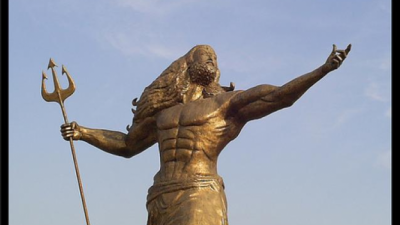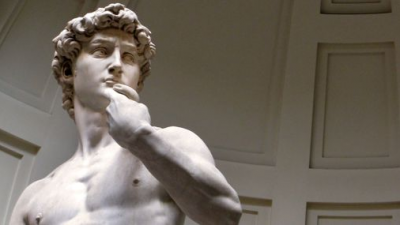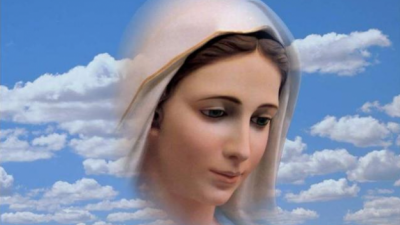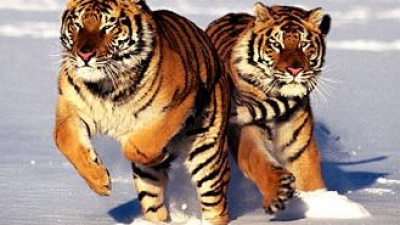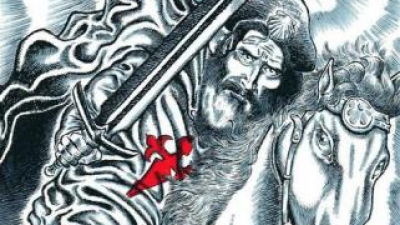The most famous goddesses of different mythologies
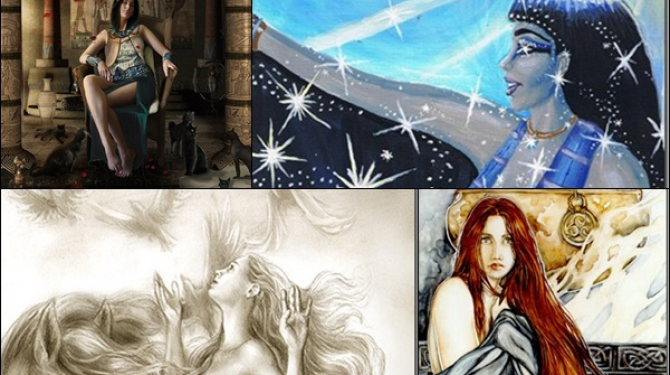
Source: listas.20minutos.es
The different mythologies of the world have goddesses, they usually represent values historically linked to the feminine gender, such as maternity, protection, kindness or fertility, although they also represent other attributes as we will see in this series of entries. Goddesses are often part of a long pantheon that includes conventional genres and, in some cases, even hermaphrodite deities. vote for your favorite ...
TOP 40:
Mawu (African mythology)
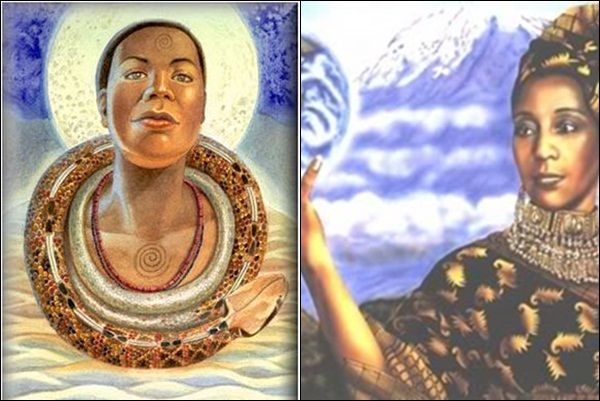
Mawu is the supreme goddess of the Fon de Abomey (Republic of Benin). Mawu, the Moon, brings cooler temperatures to the African world. She is represented as an old mother who lives in the West. Mawu has a partner named Liza. Together they created the world. His son Gu is the forger god or the divine tool. They used it to shape the universe. Snake Da also helped them during creation. Mawu was the goddess of the night, happiness, and motherhood. Liza was the god of day, heat and strength.
TOP 39:
Guan Yin (Buddhist mythology)
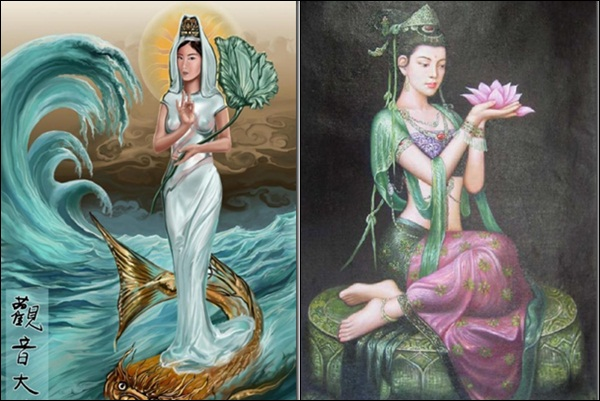
Guanyin is the bodhisattva of compassion and is revered by the Buddhists of East Asia. It is also known as the Chinese Bodhisattva of Compassion. The name Guanyin is an abbreviation of Guanshi'yin which means "the one who hears the cry of the world." The first Buddhist monk who referred to Kwan Yin as a female was Kumarajiva, translating the Lotus Sutra into Chinese in 406 AD. C. In its translation, seven of the thirty-three appearances of the Bodhisattva are female. With the introduction of Tantric Buddhism or Vajrayāna in China during the Tang dynasty, 8th century, the representation of Avalokiteśvara as a beautiful female figure dressed in white was growing in popularity. Guan Yin has vowed not to enter the celestial kingdoms until all living beings have completed their enlightenment process and are released from the cycle of birth, death and reincarnation. In popular devotion, Kuan Yin rescues those who come to her in times of difficulty, especially given the dangers caused by water, fire or weapons. The Bodhisattva understands the feelings of fear and responds to requests for help with her Compassion. As a Merciful Mother, she hears the requests of those who wish to have children. The figure of Kwan Yin maintains great similarity with other protective Mothers such as the Virgin Mary in Christianity, Isis in ancient Egypt, Tārā in Tibetan Buddhism and Śakti, Párvati, Sītā or Radha in Hinduism.
TOP 38:
Nerthus (Norse mythology)
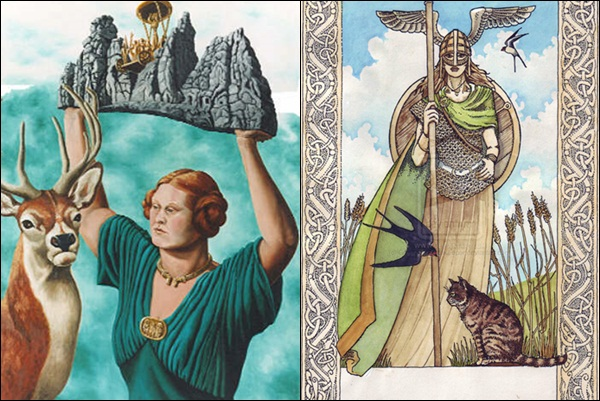
Nerthus is a goddess of Norse mythology. Nerthus was a very popular divinity in some of the Germanic tribes mainly in what would become Germany. His holiday was held in spring in which a procession was made with a car to which only the chief priest of the cult had access. It should be noted that this cult can be originated in the stone age. In the Saxon towns, she was also worshiped as mother earth, but in reality she was not a Saxon goddess, so she would relate to Tuisto (god born of the earth). The role of Nerthus in Norse mythology has been very limited, because as a goddess it belongs to the Vanir and paradoxically takes the role of mother, sister and lover of Njörðr, which takes many characteristics of her, being replaced by him as god of the fertile land. His position as mother earth is fulfilled by Jörd.
TOP 37:
Gullveig (Norse mythology)
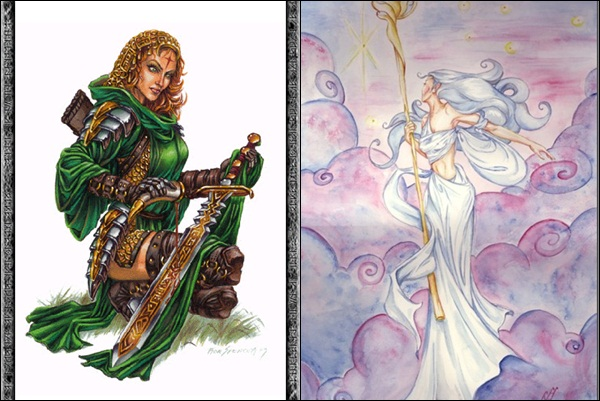
In Norse mythology, Gullveig was a mysterious goddess or giant who started the war between the Æsir and the Vanir. In a visit he made to Asgard, the aces did not support it anymore, so they created a bonfire in the center of Glaðsheimr, killed Gullveig and threw it into the bonfire. The problem was that she was resurrected, so the Æsir made three attempts, but the result was always the same. Seeing how Gullveig left the bonfire they started calling her Heid.
TOP 36:
Tiamat (Babylonian mythology)
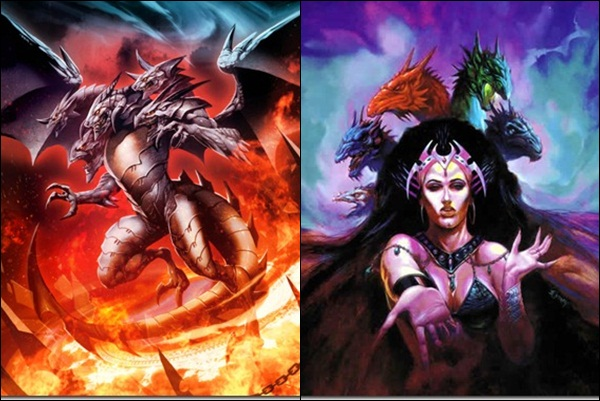
Tiamat is a primitive goddess / monster belonging to Babylonian mythology. Your name means life and love, mother. Tiamat would be the feminine principle, the sea, representation of the potentialities of pristine chaos. Female monster, evil in the Babylonian legends, the salt water that in union with Apsu (the male principle, the fresh water) gave birth to gods, and animals starting with Lahmu and Lahamu, but soon after creating them, they bothered them with his noise, the god of magic, Ea, managed to subdue Apsu, leaving him in a long stupor (that's why the fresh water is still) but he could not do anything against Tiamat who very enraged with the death of her husband created a legion of demons led by Kingu, who was his lover and one of his children. The gods decided to give all their powers to Marduk, he defeated Kingu, who was paralyzed with fear when he saw him arrive, and then to Tiamat, who made him leave his mouth open with a gale and launched an arrow into the stomach. After this, from the blood of Kingu the humans were born and from the body of Tiamat, that Marduk chained in the wells of the abyss and split in half, the sky was created from its upper half and from the lower half the mainland . His tears became the springs of the Tigris and the Euphrates.
TOP 35:
Black virgins
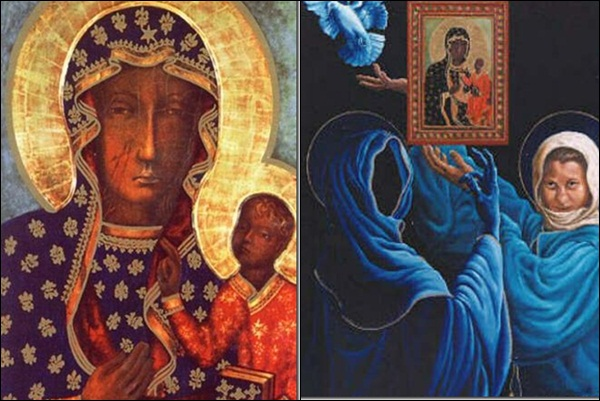
Black virgins are effigies of the Virgin Mary that represent her as dark skinned, or even completely black. Modern representations in which the Virgin has been premeditated with a black ethnic aspect does not fall into this category. The origin of these images is explained as the adoption by the popular Christian cult in its first centuries of iconographic elements and attributes of ancient female deities of fertility, whose cult was extended throughout the late Roman Empire, such as Isis, Cibeles and Sagebrush. Because of this, examples of these virgins can be found all over Europe. Veneration to black virgins also has numerous examples in America driven by the Spanish conquest. There the black virgins of the Old World arising from the Christian-pagan religious syncretism would in some cases go through an identification with Amerindian or African female deities such as Pachamama or Yemayá
TOP 34:
Samovila (vinca culture)
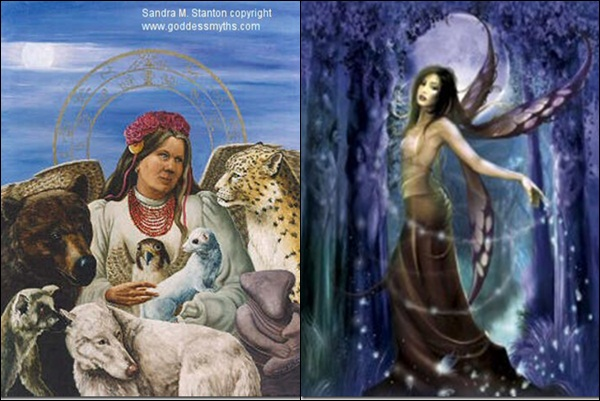
Goddess of Eastern Europe who was said to live in the depths of the forests as a protector of animals. If someone damaged any of his protected creatures, Samovila, danced in his magical circle inducing the insulting of his will to death, causing them to fall from a ravine or fall into the river. Samovila, is able to change its shape, being able to transform into a Falcon, a duck, a snake, a horse or even a whirlpool or hurricane. She taught humans how to do ceremonies correctly on full moons so that the Sun keeps rising. It is a figure that appears repeatedly in the Kosovska-Mitrovica (fafos II) of Yugoslavia in the Vinca culture (5300 - 4000 BC).
TOP 33:
Renenutet (Egyptian mythology)
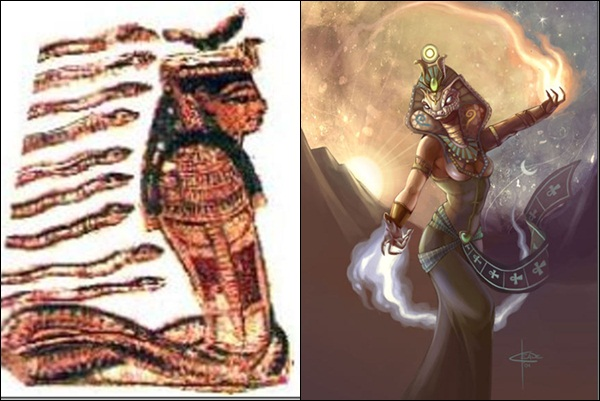
The snake goddess called Renenutet, Renenet or Ernutet. In Egypt, snakes are protective and evil deities. But Renenutet, a serpent-headed divinity, has a beneficial character; She is protective of the real child and also goddess of luck. It is linked to fertility and crops. The first drop of water, wine, beer and the first bread was dedicated to her. With his gaze he could kill the enemies and next to Seb was Nehebkau's mother. His cult was centered on Terenuthis.
TOP 32:
Oya (Yoruba mythology)
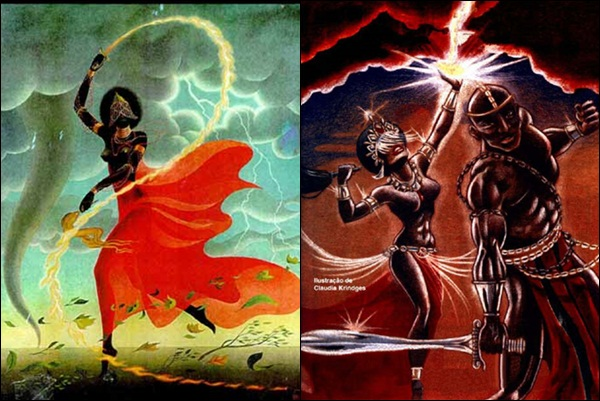
Oyá, is the goddess of storms and the strong wind that precedes them. It is said of her that it is Efuele ti 'da gi l'oke-l'-oke (the wind that sweeps and plucks the trees from the top). He ruled along with Chango. It is one of the warrior Orichas and the only one that can dominate the Eggunes (spirits of the dead). It was Oggun's great love until she left him for Chango. It is authoritative but sensual, with a very strong temperament, dominant and impetuous. She is one of Chango's wives, whom she accompanied in all her battles. She is also the owner of the cemetery, whose door or surroundings she lives in. Together with Elegguá Orula and Obatala dominates the four winds. She comes to the front, warrior and aggressive and at the same time happy. This goddess is also known by the name of Yansan, and is the only oricha that has the power to dominate the dead. Oyá represents a feminine ideal alien to the Yoruba culture. Among the Yoruba, women were not part of the army as was the case with other peoples of equatorial West Africa. According to traditions, Oyá is originally from the north of the Yoruba country. It is possible that somewhere in that area, women were used in royal cavalry as they were in the Dahomey, a nation where she is known as divinity related to atmospheric phenomena. It seems that it was in the Dahomey, where the goddess acquired her character of a bold and violent Amazon, since in Yoruba environmental realities do not seem to justify the function of the cult of a female divinity so interested in activities that in her culture are typical of men .
TOP 31:
Erzulie (Caribbean mythology)
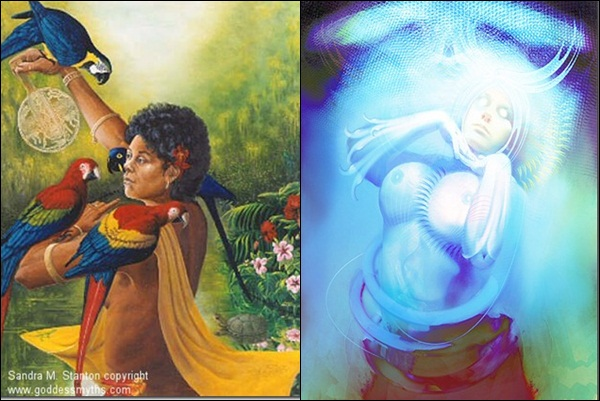
Erzulie is the goddess in Haiti of love, whose roots date back to West Africa. She is the personification of beauty, sweetness, love and sensuality, as well as generosity, arts and dance. All rivers, lakes, springs and waterfalls are part of their domains and it is said that you can use them to transfer their power in the colder waters. On many occasions, he carries a magical fan from Osgobo, Nigeria, which is carried by the priestess of Oshun, mediator between the divine and the natural in the world of humans.
TOP 30:
Ceridwen (Welsh culture)
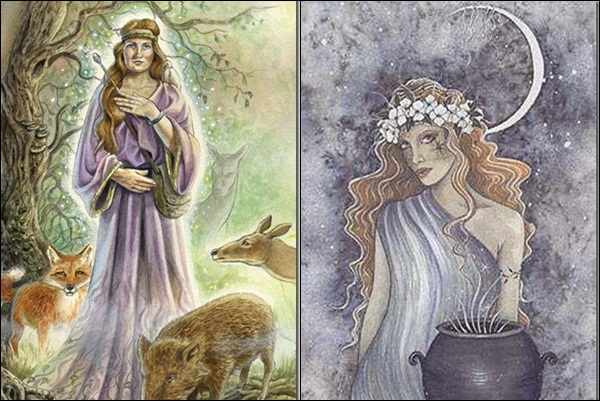
Ceridwen or Cerridwen is a Welsh goddess (often considered a witch) who possessed the cauldron of Inspiration and Wisdom. She was married to Tegid Foel and had three children, the Maid Creawy and two boys: Mofan and Morvran. Cerridwen is one of the goddesses most often found in neo-pagan rites. Although in his myth you can find the three female archeotypes (maiden, mother and witch) is related mainly to that of the "witch", which represents the waning moon within the lunar cycle. Among the elements commonly associated with their representations is the cauldron and a large sow or white javelin. The cauldron is a symbol of the feminine principle, as is the calyx or cavern and is commonly associated with the uterus, as well as processes of transformation and rebirth. The sow is a symbol of fertility and sensuality. She is considered a patron goddess of the cycles of life, death and rebirth, as well as inspiration, creativity and divination.
TOP 29:
Deví (Hindu mythology)
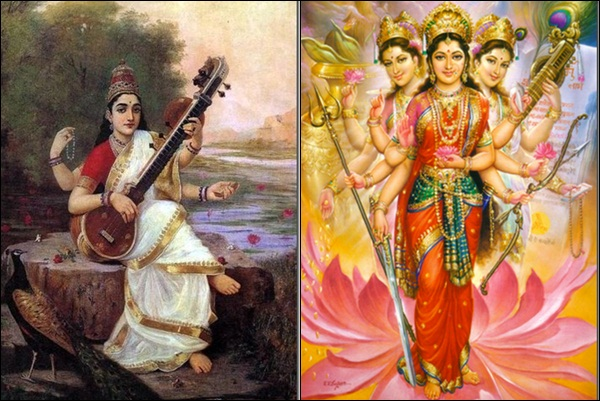
Devī is a Sanskrit word that means 'goddess'. Deví is synonymous with Shakti, the feminine aspect of divinity. It is the feminine part without which, the masculine aspect, which represents consciousness, is impotent and empty. The goddess cult is an integral part of Hinduism. Deví is essentially the heart of all Hindu goddesses. As a feminine manifestation of God, it is also called Prakriti or Maia.
TOP 28:
Chalchiuhtlicue (Mexican mythology)
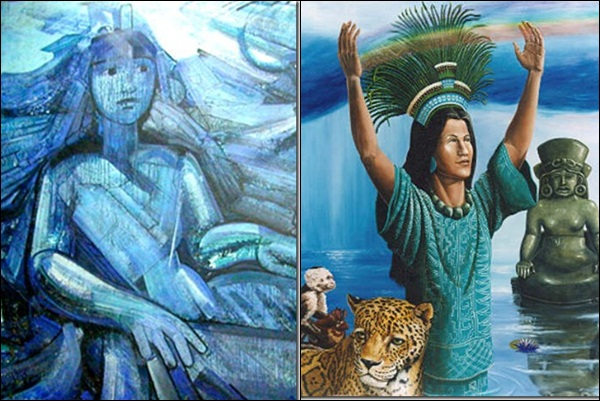
In Mexican mythology, Chalchiuhtlicue is the goddess of lakes and water currents. She is also patron of births, and plays an important role in Aztec baptisms. Presides over day 5 Snake and over the triceal of 1 Reed. It was one of the most important female figures linked to the liquid in Mesoamerican culture. Chalchiuhtlicue was also considered the most important protector of coastal navigation in ancient Mexico.
TOP 27:
Cibeles (Phrygian Culture)
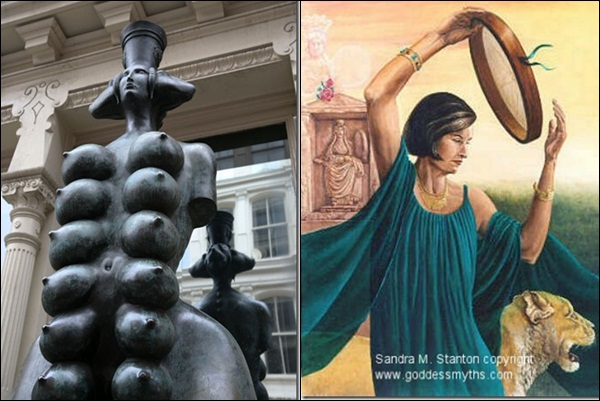
Originally a Phrygian goddess, Cibeles was the goddess of Mother Earth who was worshiped in Anatolia since the Neolithic. Like the Gea or its Minoan equivalent, Rea, Cibeles was the personification of the fertile earth, a goddess of caverns and mountains, walls and fortresses, of Nature and animals. Its Roman equivalent was Magna Mater, the Great Mother. Her title "Lady of the Animals", which also bore the Great Minoan Mother, reveals her archaic paleolithic roots. It is a deity of life, death and resurrection. His consort, whose cult was introduced later, was Atis. It is represented with a crown shaped wall and always accompanied by lions and sometimes with a woman with many breasts alluding to fertility. This goddess is represented in mythology about a car that symbolizes the superiority of Mother Nature, to which even the powerful lions that pull the car are subordinated. Additionally, to start the cult as a priest of Cibeles, they were castrated as a contribution to mother earth; They also made a sacrifice by killing bulls and drinking their blood.
TOP 26:
Pelé (Hawaiian mythology)
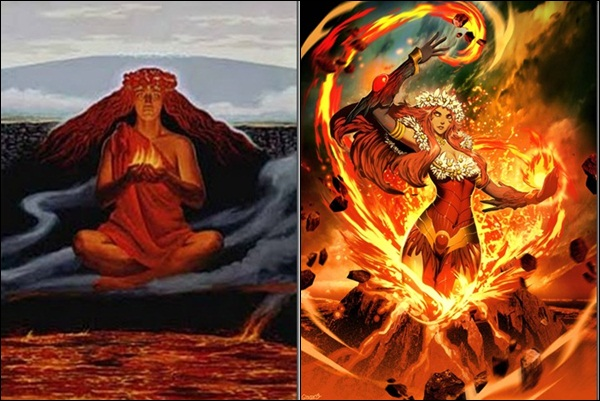
Pelé in Hawaiian mythology, is a goddess of fire, lightning, dance, volcanoes and violence. According to mythology, she is one of the daughters of Haumea and Kane Milohai. It is characterized by being a wild and rabid goddess, who according to the tradition of the natives, would inhabit the Kīlauea volcano. That is why Pele is considered responsible for the eruptions of the volcano.
TOP 25:
Ceridwen (Celtic mythology)
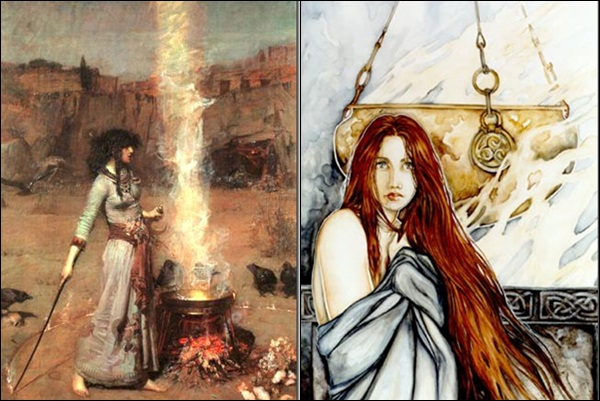
The Welsh, one of the few Celtic nations, were worshipers of the goddess Ceridwen or Cerridwen, sometimes associated with a witch, for having the cauldron of inspiration and wisdom. Even having three archetypes, maiden, mother and witch. It is also the goddess who was most rites. It is a mother goddess and a goddess of darkness. Her husband was Tegid Foel and her three children are Creawy, Mofan or Afagddu and Morvan. From these children it can be said that Creawy is the most beautiful girl in existence. His brother Morvan was ugly, but he had strength and bravery in battle. Now Mofan is a very ugly man, so ugly that not even society accepts him. This is why Ceridwen wanted to help his son Mofan because of his bad appearance. Preparing a magical portion, from which the first three drops could transform you into a great man. But the next drops is a lethal poison. The preparation was not easy, I had to put six magic herbs to cook for a year and a day. To ensure that nothing bad happens with the portion, the old and blind Morda and the young footman Gwion or Gwyon have watched. Ceridwen did not have so much confidence in these serene ones and to guarantee that they will preserve the portion, the threats that touching a small drop of the portion would have a terrible and painful death. Even with all his precautions, something went wrong. Because on one day, Gwyon removed the portion and three drops jumped in his hand and he carried it in his mouth, instinctively, giving him supernatural powers. Everything Ceridwen foresaw had failed and when he learned of the accident he tried to kill him. The young man scared of the goddess who was chasing him, and thanks to the acquired powers, he becomes a hare. For nothing in the world Ceridwen would admit that Gwyion escapes and transmutes into a dog. Gwyion with the dog on his route, transmutes into fish and jumps into the river. Ceridwen in otter. Gwyion in sparrow, Ceridwen in eagle. Gwyion in wheat grain and Ceridwen in chicken and finally catches and eats it. Something went wrong, when Ceridwen returns in his human form he perceives that he was pregnant and that this son he was waiting for is Gwyion. Therefore, he decided to wait until the day of his birth to be able to kill him. This day arrived and the boy who was born was so good looking that he did not get the courage to do. But this did not mean that he would take care of the creature, she puts it in a fur seal bag and throws it into the sea. The boy survived and arriving at the coast a prince named Elphin spotted him and adopted him. The child these days was called Taliesin. Who becomes the most talented bard of all time.
TOP 24:
Ishtar (Mesopotamian mythology)
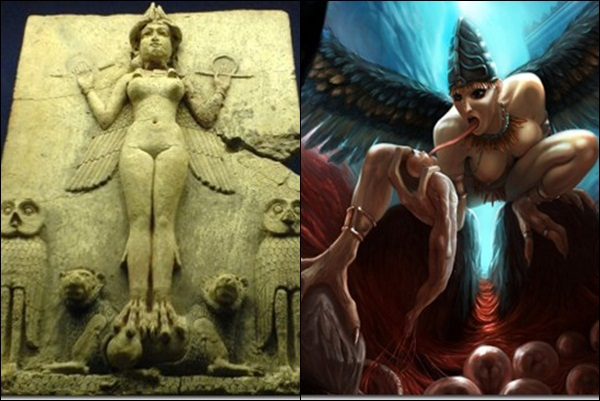
Ishtar was the daughter of the god Sin (lunar god) or Anu. As her daughter, she was the warlike lady; as a descendant of it, the exponent of love, licentiousness, intemperance and capricious violence to the extreme. As the first psychological archetype of female dynamics in history, and in contrast to her sister Ereshkigal or Ki, the earth goddess, Ishtar cannot be considered within the group of mother goddesses since her relationship with humans is more like inspiration for vital action as a refuge. With this character, Isthar appears within the epic of Gilgamesh. Its symbol is an eight-pointed star. In his honor, astronomers have called Ishtar Terra a continent of Venus. Its associated animal is the lion. Ishtar was associated with the planet Venus as a morning star. She is also represented standing, completely naked, with her hands on her belly, or holding her breasts, or wielding a bow on a car pulled by seven lions. In her aspect of loving divinity, Isthar is the protector of prostitutes and extramarital affairs, which by the way had no special connotation in Babylon, since marriage was a solemn contract that perpetuated the family as a support for the state and as a generator of wealth , but in which there was no talk of love or loving fidelity. Ishtar is not a goddess of marriage, nor is she a mother goddess.
TOP 23:
Sarasvati (Hindu mythology)
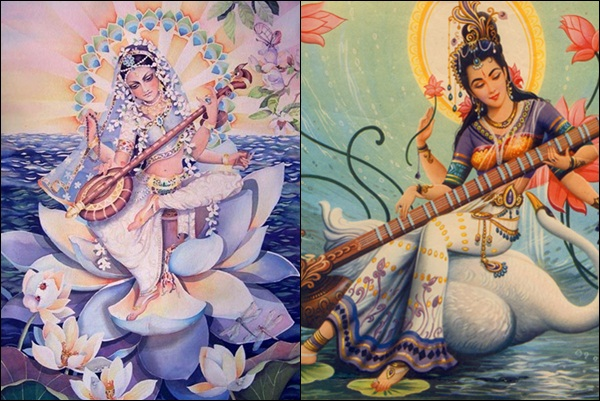
In Hinduism, Sárasuati is the goddess of knowledge and one of the three main goddesses (the other two being Lakṣmī and Durgā). She is the wife (or daughter, or both) of the god Brahmā. Sarasuatī was a goddess worshiped in the Vedic religion. She is the goddess of learning and the arts (for example, of music). She is also worshiped as the goddess of truthful thoughts and forgiveness. It is mentioned in both the Rig-veda and the Puranas. It is likely that she started as a merely fluvial goddess, related to the Sarasuati River, since her name in Sanskrit means' the [area] that has lakes' (saras: 'something fluid', a lake, a pond, vatī: ' the one that owns'). Some "stretch" the translation to mean "the one that flows," which can be applied to the mind, words, ideas, or the current of a river. In the Rigvedaa Sárasuatī the destruction is attributed to him, by means of the god Indra, of Vritrasura, a gigantic demon that had monopolized all the water of the known world, and that represented the drought, the darkness and the chaos.
TOP 22:
Oshun (Yoruba mythology)
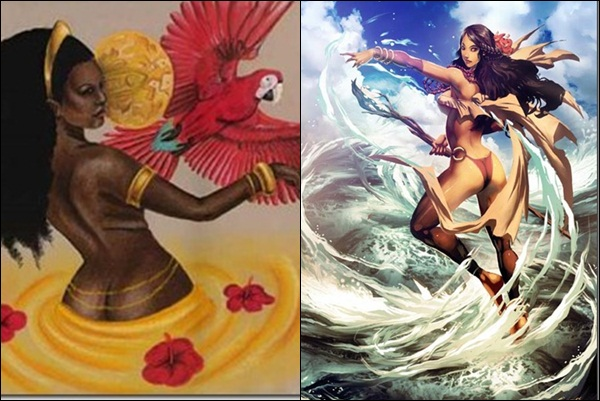
Oshun is one of the deities of the Yoruba religion. In the syncretiza santería with the Virgin of the Charity of the Copper, employer of Cuba. It is also transliterated as: Oxum or Ochun. Oshum is the Orisha of fresh waters, of sensuality, coquetry, female sexuality, love, fertility. It is also asked by the man that one wants for a serious relationship and that one wants. Owner of love, femininity and the river. Its name means sensuality, love, romanticism, delicacy, sweetness, happiness, water, serenity, the moon and gold, among other things. Oshum is much more. She is to blame for two men killing each other for her. It is the symbol of coquetry, grace and female sexuality. It assists pregnant women and women in labor. Eternally cheerful, with the persistent jingle of its bells.
TOP 21:
Ixtab (Mayan mythology)
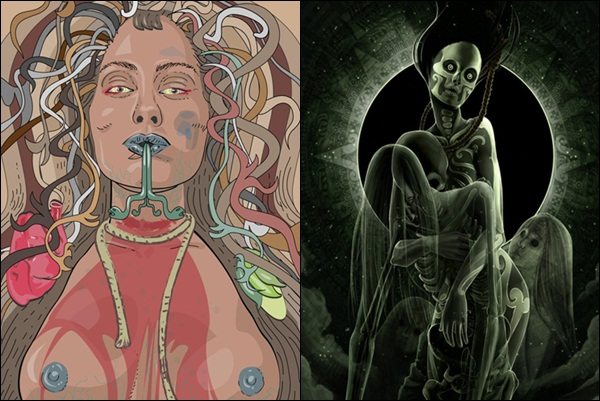
Ixtab is the goddess of suicide, and wife of the god of death, Chamer, in Mayan mythology. It was also the divinity of the gallows. In the Mayan tradition, suicide was considered an extremely honorable way to die, at a level similar to that of human victims of sacrifices, warriors fallen in battle, dead women in childbirth, or priests. Ixtab was commonly depicted as a partially decomposed corpse with eyes closed, hanging from a tree. His role as a divinity was to protect the suicides, accompanying them and leading them to a special paradise. This paper is called a psychopompo or soul guide. Due to its popularity, some historical documents propose the theory that the cult of Ixtab prompted the people of Central America in Mayan times to commit suicide rather than face humiliation, illness, or misfortune, creating a wave of suicides among people high caste, similar to seppuku in Japanese tradition.
TOP 20:
Epona (Celtic mythology)
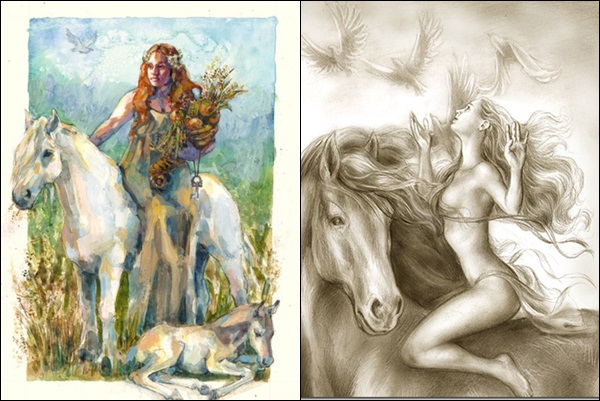
Epona or Épona is the Celtic goddess of horses, fertility and nature, associated with water, healing and death interchangeably, comparable to Cibeles. She is represented sitting on the back of a horse, standing in the middle of a herd of horses or feeding the foals, and in Gaul as an aquatic nymph or ondina. Her attire is long clothes, covered with a mantle over the head and a headband, although sometimes she can go naked. The name Epona derives from the Celtic word Epos, horse, and was identified with the deity Iccona. It can look like a mare. Its main attributes are a patera (a bowl of little background that was used in ancient sacrifices), baskets of fruit or cereal and the Cornucopia or horn of plenty in hand, possibly a Roman addition to its iconography. It became the preferred deity of the Roman cavalry, and in fact coins are known in which the goddess is shown with a horse's head and images of her adorning the stables and stables. Besides being venerated in the army, she was a domestic divinity, as goddess of abundance or prosperity. It was the only gala goddess of the Roman pantheon.
TOP 19:
Sekhmet (Egyptian mythology)
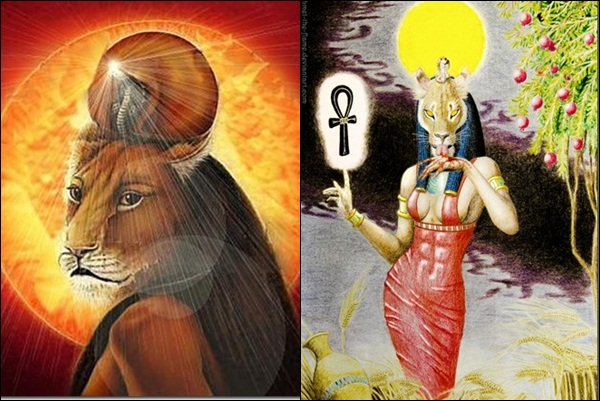
Sekhmet say that her name comes from sejem or is violent, she is goddess of Rehesu also in the Delta. She is Bastet's sister and daughter of Ra (The Sun God) who sent her to punish humans for stopping to worship him, but she went too far, she was very fierce, Ra got scared and to stop her drunk, and in each Party was preparing a special beer for her. She is the Warrior Goddess, she accompanied the pharaoh in battle and protected him from his enemies. She is also "The Lady of the Mountain of the West", sovereign of the House of Flames and they put her "The one that slows the darkness", she is the Patroness of the doctors, because with her witchcraft she was a good healer, she healed the fractures and they called her "Magic Expert." They told her The Goddess of Love, she was the prettiest among the Gods, she was also "Sovereign of the desert" also of lions and snakes. She was depicted as a woman dressed in red with a lioness's head or as a lioness.
TOP 18:
Brigit (Irish mythology)
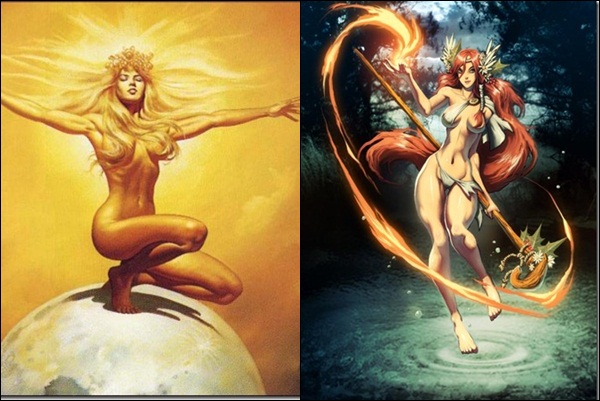
In Irish mythology, Brigid, Brigit or Brighid (the exalted) was the daughter of Dagda and a Tuatha Dé Danann. She was the wife of Bres de los Fomorianos, with whom she had a son, Rwanda. He had two sisters, also called Brigid, and is considered a classic Celtic triple goddess, in this case of fire. She is the Celtic goddess of inspiration, and combines in itself various powers, coming from inspiration, the art of healing and divination. It was associated with sacred perpetual flames, such as that held by 19 nuns in a sanctuary in Kildare, Ireland. The tradition of female priestesses who tend to eternal sacred flames, which arise naturally, is a characteristic of pre-Christian ancient Indo-European spirituality. Other examples include the Roman goddess Vesta, and other household goddesses. It was mentioned by Giraldus Cambrensis and other chroniclers that his sacred flame in Kildare was surrounded by a hedge, which no man could cross. It is said that the men who tried to cross the hedge were cursed with madness, death or impotence.
TOP 17:
Ixchel (Mayan mythology)
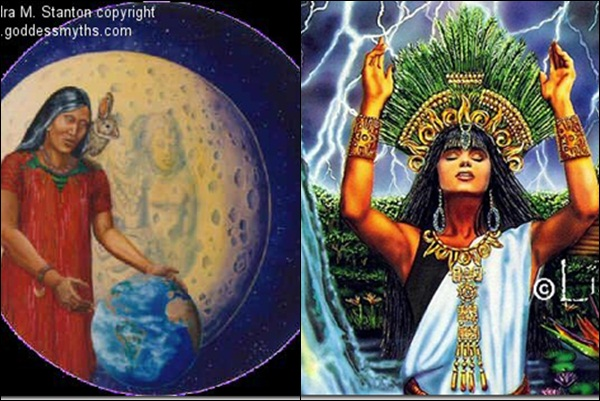
In Mayan mythology Ixchel was goddess of love, pregnancy, textile works, the moon and medicine. On some occasions he was represented accompanied by a rabbit. One of his advocations was considered malefic, and he was represented in the codices, like an old woman, emptying the wrath of anger over the world. Mythological legends tell that an almighty god named Itzamná, son of the creator god of the world named Hunab Ku, married the moon goddess named Ixchel procreating the gods Yum Kaax (corn god), Ek Chuah and the gods of the sacrifices and the stars; His daughters were the goddesses of the waters, of the night and of paradise. Goddess Ixchel is credited with the phenomena related to the Moon, pregnancy, tissue and floods. He was represented as an old woman emptying a pitcher full of water on the ground or also as an old woman knitting on a waist loom. Its temple is located on the island Cuzamil (Cozumel) of the province of Ecab. From the port of Pole (today Xcaret) the pilgrim canoes left for the temple in Cuzamil to request the oracle of this goddess; In this pilgrimage young women also came to ask in their pregnancies to procreate children that their husbands wanted. Ixchel is said to take pilgrims under his protection to visit his sacred island, Cozumel. Isla Mujeres was also dedicated to its cult. Ixchel is venerated as the moon goddess, for her feminine character. It represents fertility closely linked to the Earth, since it is the cycles of the moon that govern the sowing and harvesting times. It is also associated with rain and Chaac for this same concept.
TOP 16:
Nut (Egyptian mythology)
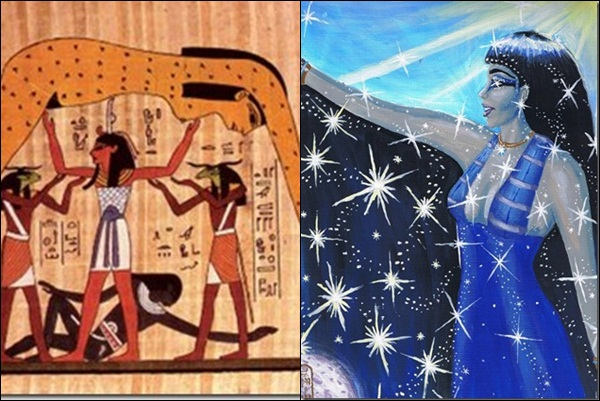
Nut, or Nuit, "The Great that bore the gods", is the goddess of heaven, creator of the universe and the stars, according to Egyptian mythology. Daughter of Shu and Tefnut, wife of his brother Geb, and mother of the gods Osiris, Isis, Seth, Nephthys and Harmakis. In Heliopolis she was Ra's mother and was identified with a cow (Mehet-Urt). Nut, daily gave birth to the Sun that traveling over his body reached his mouth, disappearing inside (or in the Duat), being reborn the next day. Protector of the dead, who came to her for food and protection, gave the deceased the power to be reborn. In the sarcophagi, she was represented by protecting the deceased with outstretched wings, or inside, as a woman with arms raised, helping him to be reborn in the Hereafter, or as a representation of heaven. His abode was a sycamore (fig tree) in Heliopolis and its branches were a refuge for tired souls. According to tradition it was the sycamore under which the Virgin Mary sat to rest on her trip to Egypt.
TOP 15:
Guan Yin (Buddhist mythology)
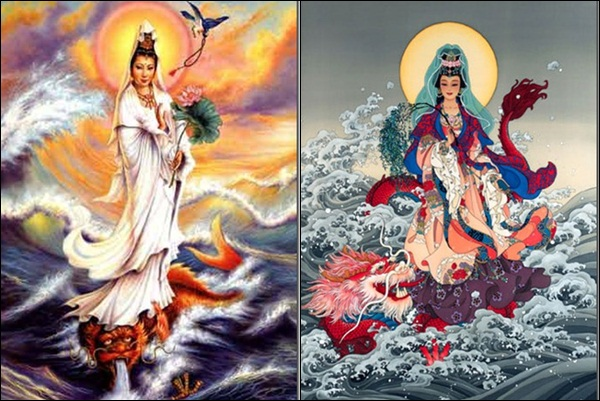
Guanyin is goddess of compassion and is revered by the Buddhists of East Asia. The name Guanyin is an abbreviation of Guanshi'yin which means "the one who hears the cry of the world." In the West it is usually known as the "Goddess" of mercy, its most outstanding quality. In Taoist mythology it is known as Ci Hang Zhen Ren and is revered and considered immortal. Guan Yin has vowed not to enter the celestial kingdoms until all living beings have completed their enlightenment process and are released from the cycle of birth, death and reincarnation. In popular devotion, Kuan Yin rescues those who come to her in times of difficulty, especially given the dangers caused by water, fire or weapons. The goddess understands the feelings of fear and responds to requests for help with her Compassion. As a Merciful Mother, she hears the requests of those who wish to have children. The figure of Kwan Yin maintains great similarity with other protective Mothers such as the Virgin Mary in Christianity, Isis in ancient Egypt, Tārā in Tibetan Buddhism and Śakti, Párvati, Sītā or Radha in Hinduism.
TOP 14:
Coatlicue, (Mexican mythology)
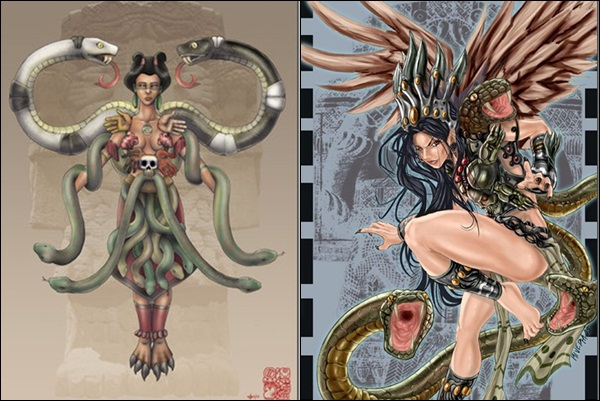
Cōātlicuē is a Mexican divinity, mother of Huitzilopochtli. Its name means in Nahuatl 'The one with the snake skirt'. Earth goddess of life and death. He also received the names of Tonāntzin and Teteōīnān. She was depicted as a woman wearing a skirt of snakes and a necklace of hearts that were torn from the victims of the sacrifices. He had sharp claws on his hands and feet. Coatlicue was a mother goddess to the Mexica. Her husband was Mixcoatl, the cloud snake and god of persecution. As a virgin, she enlightened Quetzalcoatl and Xólotl. It is the feminine part of the universal duality: Quetzalcoatl / Cihuacoatl, or snake woman. Goddess of the earth and fertility, she also shows a darker side, in various representations half of her face is of woman and the other half shows a stark skull, thinking about the decomposition and degradation that makes fertile land first . Coatlicue, mother goddess, is a clear example of the duality on which pre-Columbian cosmology seems to be based, the intrinsic relationship of life and death, two sides of the same concept. Coatlicue was the mother of the god Huitzilopochtli. She gave birth to Huitzilopochtli after a feather was stuck in her belly while she was sweeping over the Coatepec (Serpent Hill). That mysterious pregnancy offended her other four hundred children (the Centzon Huitznahua) who, instigated by her sister Coyolxauhqui, decided to kill her dishonored mother to avenge her father Mixcóatl. They did so, but Huitzilopochtli left his mother's stomach completely armed and ended up with his star brothers and sisters. Huitzilopochtli cut off the head of his sister Coyolxauhqui and threw it into the sky where it became the Moon. That story was represented in the Main Temple of the ceremonial precinct of Tenochtitlan, because the great pyramid of Huitzilopochtli represented the Coatepec (it was constellated of snake heads in stone), and at its feet lay the dismembered Coyolxauhqui monolith.
TOP 13:
Yemayá (Yoruba mythology)
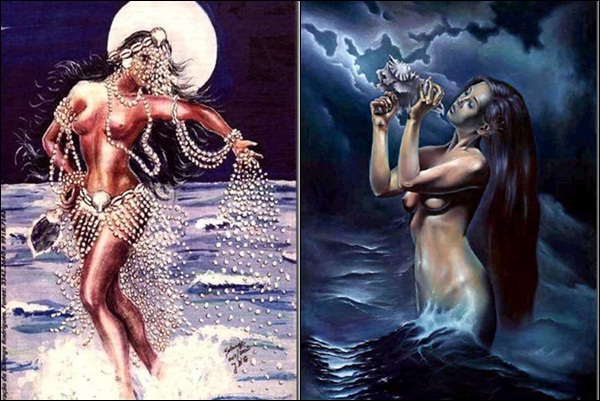
Yemayá is a divinity that is part of Yoruba mythology, it is one of the main orixás, in fact it is the mother of them all. Synchronize with the Virgin of Regla and Stella Maris in religions such as Santería. It is a female orisha, although they are gods and not creatures are governed by sex like any human being. It is the deity of salt water. It is native to Obeokuta, but its main worshipers are from the village of Egbado. The Queen of the Eggun is Onoto, who is also known as Obsa. Yemayá is as old as Obatala, and so powerful, that she is said to be the most powerful, but because of her snatched character she lost the hegemony of the world, and was given the domain of the surface of the seas, that when moving from right to left, represents the movement of the waves, and the character of his personality. It is the owner of the waters and represents the sea, a fundamental source of life and beliefs. The prohibitions are defined in the ceremonies by the snail in a personalized way for each initiate. They usually have to do with meals that are offered to the deity and that are their own, especially fish and shellfish.
TOP 12:
Wicca
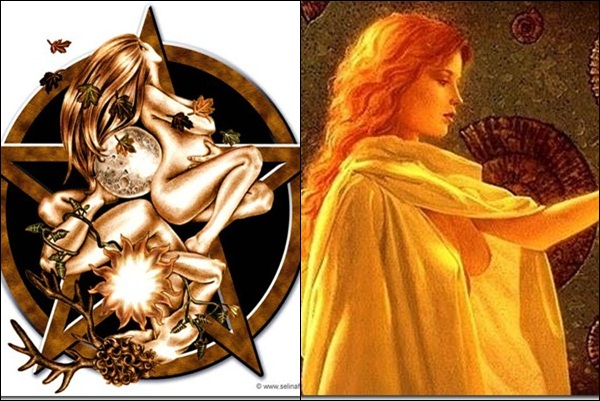
In Wicca "the goddess" or "the lady" is one of the most important deities along with her consort, the horned god. She is described as a tribal goddess of the cult of witches, which seems inspired by Aradia, Diana's messianic daughter described in Charles Leland's Aradia. She was not considered to be omnipotent or universal and it was recognized that there was a "Higher Power", even though the witches did not care too much about this being. In many manifestations, Wicca, the goddess, has been considered as a universal deity, which is in accordance with her description in the Charge of the Goddess, a key Wicca text. In this way, she is the "Queen of Heaven" similar to Isis; She also encompasses and conceives all life in a similar way to Gaia. Similar to Isis and certain late classical conceptions of Selene, she is interpreted as the sum of all the other goddesses, which represent their different names and aspects across different cultures. The goddess is often represented with a strong lunar symbolism, inspired by different cultures and deities such as Diana, Hecate and Isis, and is often represented as the triad "Virgin", "Mother" and "Old Witch". Many representations of her take elements of Celtic goddesses. Some Wicca believe that there are too many goddesses and in some manifestations of Wicca, particularly Wicca Diana, only the goddess is revered and the god practically plays no part in veneration and ritual.
TOP 11:
Gea (Greek mythology)
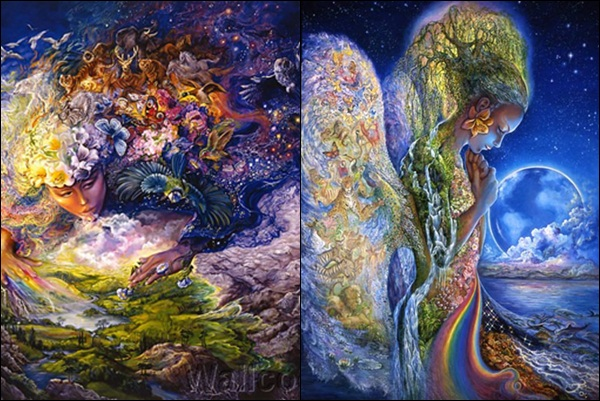
Gea or Gaya is the primordial goddess who personifies the Earth in Greek mythology. It is a primordial and ctonic deity in the ancient Greek pantheon, considered the Mother Earth. Its equivalent in the Roman pantheon was Terra Mater or Tellus. The Romans, unlike the Greeks, did not systematically distinguish a Titan (Earth) from a goddess of grain, Ceres. Gea is the mother Earth from which all divine races arise. She is born after Chaos and before Eros (Love). She alone begat Uranus (Heaven) that covers her just like Ponto (the sea). Then he joins Uranus and gives birth to the six titans: Ocean, Ceo, Crío, Hyperión, Japeto and Cronos. He also had the six titanids: Aunt, Rhea, Themis, Mnemosine, Febe and Thetis (mother of the Achilles hero). Then the cyclops (giant monsters with one eye), divinities related to lightning and thunder were born. Finally, the Hecatonchires were born, beings with a hundred arms, gigantic and violent. Most theogonies attribute to Gea the maternity of various monsters such as Caribdis, the Harpies, Python, the guardian dragon of the Golden Fleece, and even Fame. Over time, Gea became the universal mother, and as the Hellenic world personified her gods, the earth became embodied in divinities such as Demeter or Cibeles, and the earth as an element abandoned mythology. Gea also considered herself, as inspiring of many oracles, she possessed the secrets of Destinations, and her predictions were older and safer than those of Apollo herself.
TOP 10:
Scatha (Celtic mythology)
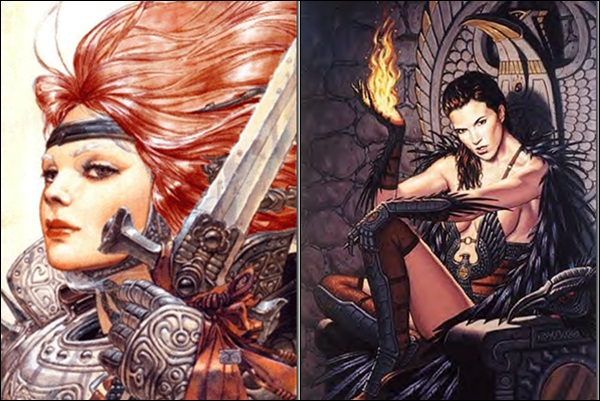
Scatha or Scáthach, a goddess also considered a great warrior, whose name means "the one that causes fear," which is also called "the shadow." She lived on the Isle of Skye in Scotland, and taught many of the legendary Celtic heroes all their skills, including magic battlefield. These traveled great distances to study with her and she instructed them in strategic movements, as well as martial arts. During their one-year and one-day stay, so she taught them fierce battle cries and terrifying jumps and blows, making them invincible in combat. She is described as a professor at Cuchulainn in the Quégne Táin Bó. After the students finished learning, she sent them back to her people to do great works. There is a Celtic tomb / altar in Ciumesti, Romania, third century before Christ, as in Snettisham (Norfolk), England, in the middle of the 1st century BC dedicated to this goddess. In these alters she is seen standing on a hill overlooking the Callanish stone circle. There are numerous statues of the figure of the goddess on the left in Kerguilly s Dinéault, Finisterre, France dating from the 1st century BC. During the Iron Age, the Celts wore helmets with images of some birds or animals to emulate a more menacing appearance and because their goddess Scatha demanded it, the hen or the rooster was very frequent in the helmet since it symbolizes the warrior since it The chicken is aggressive, on alert, and is an excellent guardian.
TOP 9:
Amaterasu (Shintoism)
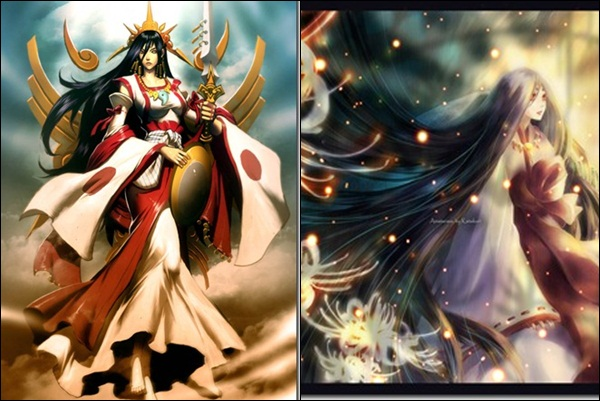
Amaterasu was the goddess of the Sun in the oldest Japanese religion called Shintoism. When her brother Susanowo treated her badly, she hid in the cave of heaven and closed the entrance with a huge stone. This made the world dark, and evil spirits came out of their hiding places. Desperate, the gods at a conference decided to cheat him out, and held a party near the cave. They put a huge mirror in front of the cave and precious jewels on a tree. Uzume, the god of laughter, began a dance accompanied by loud music. Hearing the music and laughter, Amaterasu felt so curious that he looked out to know what was going on. She was so fascinated with her own bright reflection in the mirror that she left the cave. Finally, light covered and colored the world once more.
TOP 8:
Bastet (Egyptian mythology)
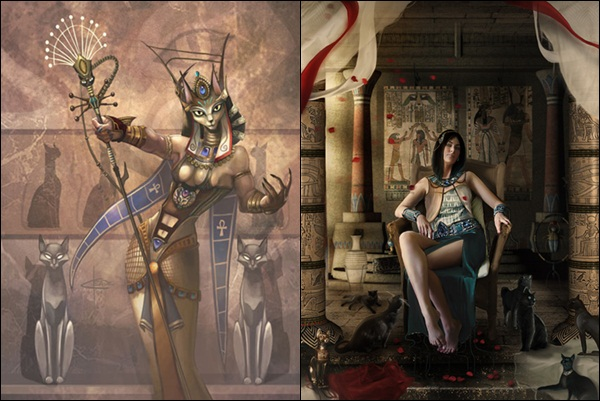
Bastet is a goddess of Egyptian mythology, also called Bast, whose mission was to protect the home and symbolizes the joy of living, because it is considered the deity of harmony and happiness. It is the personification of the warm rays of the Sun and exerted its beneficial powers. It embodied the peaceful aspects of dangerous goddesses such as Sekhmet, which expressed the evil qualities of the Sun. As an eye of Atum, it was associated with the Moon and protected the births and pregnant women from diseases and evil spirits. She is a peaceful goddess but, when she gets angry, she transforms into a lioness-headed woman, assimilating the goddess Sekhmet and, sometimes, she is much more violent than this. Like the totemic animal that represents her, Bastet was an unpredictable goddess who could be tender or fierce at any time. Sometimes she appears as the daughter of Ra or Atum, taking Hathor or Tefnut as a mother. On other occasions, it forms a triad with Atum or Mahes "The Lion of Fierce Look" as husbands, and with Horhekenu as a son. From the Ancient Empire, she is the mother of the king, whom she helps and protects to reach heaven. She was identified with the star Sirius, who was considered Lady and with the Sumerian deity Inanna. According to some scholars, such as M. Oldfield Howey, his name means heartbreaking, despite his mostly benign character.
TOP 7:
Xochiquétzal (Mexican mythology)
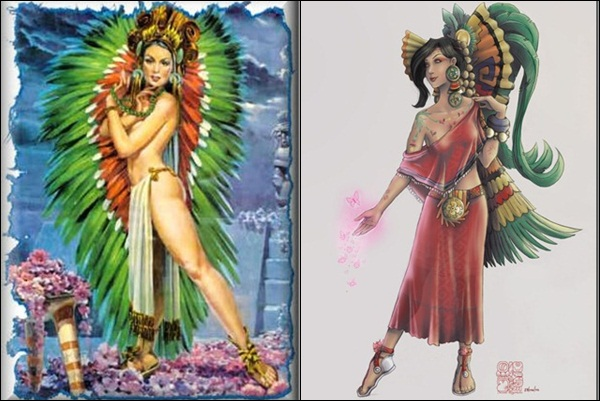
Xōchiquétzal its name means Xochitl, flower and Quetzal, beautiful; 'florid bird', 'rich flower and feather' or 'beautiful flower', and is the young goddess of beauty, flowers, love, loving pleasure, and the arts. She is one of the two goddesses related to the fertility of nature and beauty, perhaps that is why she is represented as daughter or wife of Centéotl. Xochiquétzal, "precious flower", was born from the hair of the mother goddess.
TOP 6:
Selene (Greek mythology)
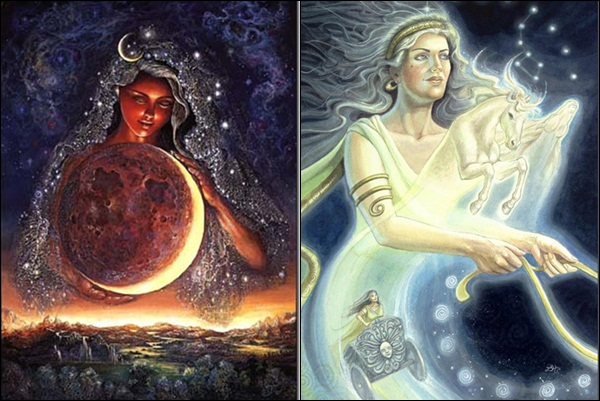
In Greek mythology, Selene was an ancient lunar goddess, daughter of the Titans Hyperion and Tea. Its equivalent in Roman mythology was the goddess Luna, who had a temple on Mount Aventine built in the sixth century BC. C. which was destroyed in the great fire of Rome in the time of Nero. The moon goddess is invariably a leading role. If his name is Greek, he is connected with signs, "light." Selene ended up being largely supplanted by Artemis, so that later writers described her as a daughter of Zeus or Palas. In the Homeric hymn to Hermes, with his characteristically insistent patrilineality, he is the "brilliant Selene, daughter of Pallas, son of Megamedes." In the traditional divine genealogy, Helios, the sun, is her brother: after he finishes his journey across the sky, Selene starts his when night falls on the earth. His sister Eos is the goddess of the dawn, who also had a human lover, Cephalus.
TOP 5:
Isis (Egyptian mythology)
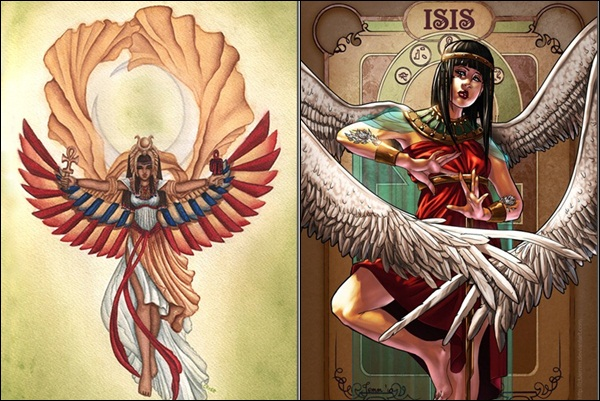
Isis is the Greek name of a goddess of Egyptian mythology. His Egyptian name was Ast, which means throne, represented by the hieroglyph that he carried on his head. It was called "Great Magician," "Great Mother Goddess," "Queen of the Gods," "Fecunding Force of Nature," "Goddess of Motherhood and Birth." Osiris, brother and husband of Isis, reigned in ancient Egypt with peace, harmony and wisdom. The Nile fertilized the land and crops were abundant. His subjects were happy. One day, Osiris went on a trip to meet other civilizations and left the kingdom under the command of his wife Isis. Seth, his envious brother, felt humiliated because he believed he should rule and not Isis. When the god Osiris returned, Seth wanted to make a great welcome party and threw a challenge to the guests: he who entered the chest that Seth had brought, he gave it to him as proof of fidelity and respect. Many tried but the coffer was small or large. Osiris, curious, wanted to try and fit perfectly well. Seth knew the size of the brother and that was why the chest had served as a glove. Immediately the brother, together with 72 accomplices, closed the metal box tightly and threw it into the Nile. Isis, with love and confidence, began her journey to recover her husband's body. After long and painful walks through Egypt, the goddess finds the chest with the remains of Osiris. But the drama continues when Seth, in his endless evil, stole the corpse and cut it into fourteen pieces that, again, scattered throughout the kingdom. Isis does not give up and, in the company of her sister Neftis, Seth's wife, travels through every place in the kingdom. Finally they manage to find all the pieces with the exception of the penis. However, Isis rebuilt Osiris aided by Anubis and Nephthys, and impregnated him conceived Horus child "Harpocrates", who would later avenge his father fighting Seth.
TOP 4:
Lilit (Mesopotamian mythology)
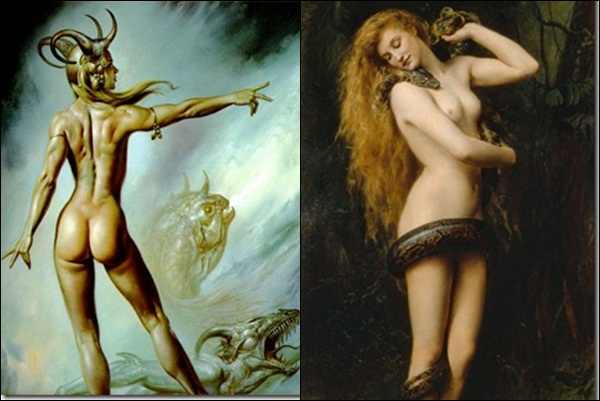
Lilit (or Lilith) is a legendary figure of Jewish folklore, of Mesopotamian origin. He is considered Adam's first wife, prior to Eve. He left Eden on his own initiative and settled by the Red Sea, joining there with Asmodeus, who would be his lover, and with other servants. Later, she became a witch who kidnaps children in their cribs at night and joins men like a succubus, begetting children (the lilim) with the semen that men involuntarily spill when they are sleeping (night pollution) . It is represented with the appearance of a very beautiful woman, with long curly hair, usually redhead, and sometimes winged.
TOP 3:
Artemis (Greek mythology)
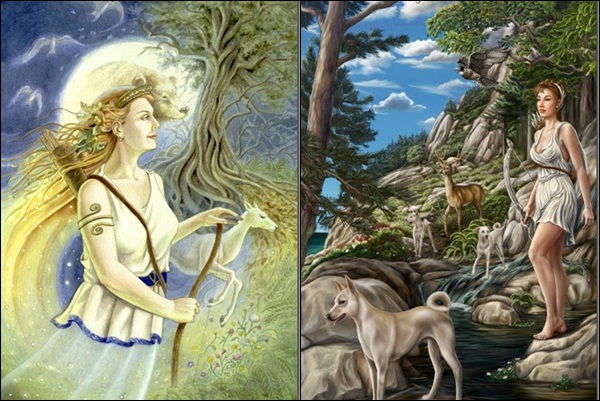
Artemis or Artemis (mythology), in Greek mythology, one of the main goddesses, equivalent of the Roman goddess Diana. She was daughter of the god Zeus and Leto and twin sister of the god Apollo. She was the rector of the gods and goddesses of hunting and wild animals, especially bears, Artemis was also the goddess of childbirth, nature and crops. As the moon goddess, she was sometimes identified with goddess Selene and Hecate. Although traditionally a friend and protector of youth, especially girls, Artemis prevented the Greeks from leaving Troy during the Trojan War until they offered him the sacrifice of a maiden. According to some accounts, just before the sacrifice she rescued the victim, Iphigenia. Like Apollo, Artemis was armed with bow and arrows, weapons with which he often punished mortals who offended her. In other legends, she is praised for providing a sweet and placid death to young girls who die during childbirth.
TOP 2:
Freya (Nordic mythology)
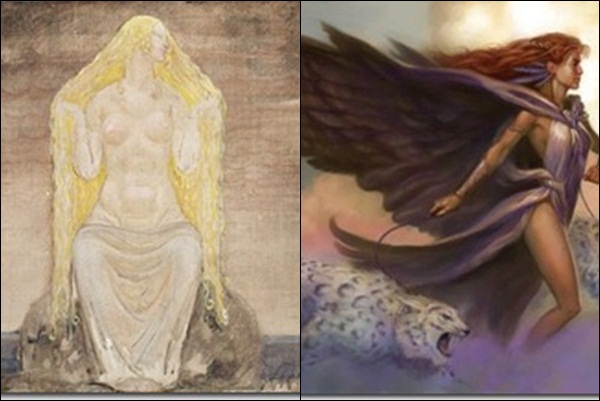
Freya, the beautiful Nordic goddess of beauty and love, was Frey's sister and daughter of Njörd and Nerthus, or Skadi. She was the most beautiful and the most beloved of all the goddesses and, while in Germany she was identified with Frigg, in Norway, Sweden, Denmark and Iceland she was considered a different divinity. Freya, having been born in Vaneheim, was also known as Vanedis, the goddess of Vanes, or as Vanebride. When he arrived in Asgard, the gods were so enchanted by their beauty and elegance that they granted him the kingdom of Folkvang and the great palace of Sessrymnir (the spacious seating), where they assured him that he could easily accommodate all his guests.
TOP 1:
Athena (Greek mythology)
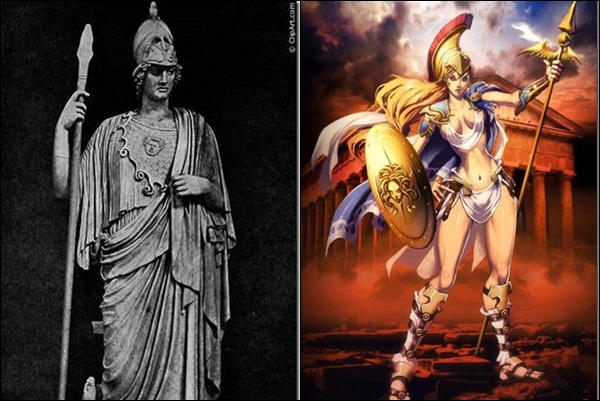
In Greek mythology, Athena or Athena is the goddess of wisdom, strategy and just war. She was considered a mentor of heroes and adored since ancient times. The goddess Athena is intelligence, and that is why she is born from the head of Zeus. She is the goddess counselor and protector of the city and political institutions. He introduced the olive tree in the Attica as a symbol of civilization, and is also the patron saint of skilled craftsmen. Its city is Athens and its temple is the Parthenon. Goddess of just war. His ductile character fits perfectly with that of the cunning Odysseus, that multi-resource hero, the trickster.

